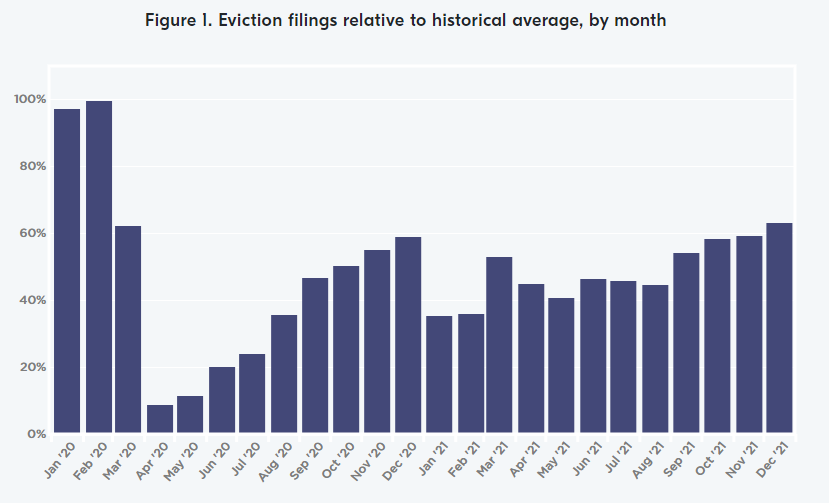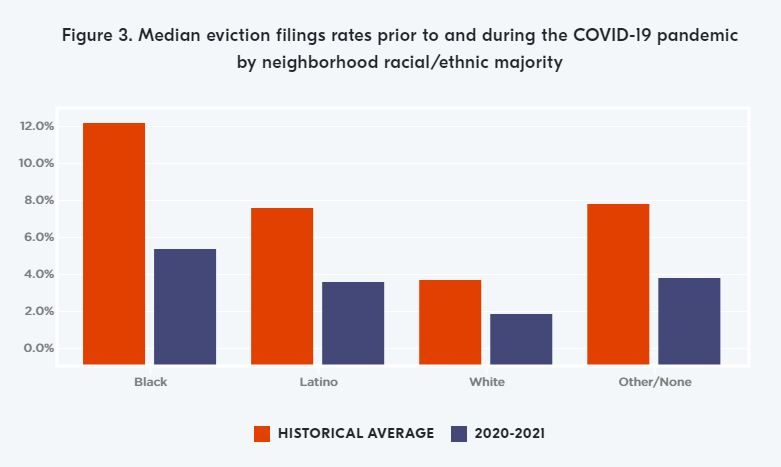According to a new study from The Eviction Lab, pre-COVID, one in every six renters faced an eviction filing each year in a typical high-eviction neighborhood. That fell to only one in twelve renters risking eviction during the pandemic.
As millions of people were laid off over the course of just a few weeks in spring 2020, COVID-19 lockdowns were put in place nationwide. Job losses were concentrated in industries that employ a large number of renters, especially the retail, service, and tourism sectors. With few jobs available and limited savings, these tenants were at immediate risk of eviction if they could not pay next month’s rent. Evictions in turn raised the prospect of more households ending up homeless or doubled-up with friends or relatives, conditions that fostered the spread of COVID-19.
Responding to the unfolding emergency, policymakers at the federal, state, and local levels enacted a range of new policies. These included eviction moratoria to prevent immediate displacement, stimulus payments and expanded unemployment insurance that allowed many tenants to stay current on rent, and emergency rental assistance (ERA) to help them catch up if they fell behind.

These policies drove eviction filing rates to historic lows. The Eviction Lab observed 800,000 fewer eviction cases filed than normal in 31 cities analyzed, representing a reduction of 57.6%
In a research article published in RSF: The Russell Sage Foundation Journal of the Social Sciences, experts tracked these patterns in 31 cities across the United States. The Lab assess the cumulative effects of pandemic-era policies, analyzing changes in eviction filing patterns over the first two years of the COVID-19 pandemic. They pay particular attention to what these policies did to address socio-economic, racial/ethnic, and gender disparities in eviction risk that predated the pandemic.
In the article, experts draw on the records of eviction case filings from cities across the country that were collected through the Eviction Tracking System. Those include five of the ten largest cities in the U.S.—Dallas, Houston, New York City, Philadelphia, and Phoenix—but also a number of smaller places like Gainesville, FL, and Wilmington, DE. All of these cities were covered by some form of local eviction moratorium at the start of the pandemic, often closing courts due to public health concerns. However, many state and local governments began rolling back protections in mid-2020: half of these cities had no meaningful emergency eviction protections in place after August 31, 2020.
Between the start of the pandemic and the end of 2021, The Eviction Lab recorded the filing of almost 600,000 eviction cases in these 31 cities. Under normal circumstances, over 1.4 million cases were expected to be filed over the same timeframe.
Filings were reduced most dramatically in the early months of the pandemic, dropping as low as 8.6% of historical average in April 2020. By fall 2020—with the CDC eviction moratorium in place nationwide—this rate had increased to approximately 50% of historical average. Filings remained around this level throughout the duration of the CDC moratorium, and increased slightly after it was struck down by the U.S. Supreme Court in late August, 2021.
Eviction filings were reduced much more in some cities than in others. Differences in how county courts interpreted and implemented federal eviction moratoria—as well as establishment of additional state- or local-level protections—led to a lot of variation in eviction filing rates. Case filings ranged from 78.2% of the historical average in Las Vegas to 15.2% in Austin.
Based on where they lived, a tenant struggling to pay rent was at much greater risk of receiving an eviction filing in Columbus, OH, than in New York. For example, except under exceptional circumstances, landlords in Minneapolis-St. Paul could not start the eviction process between March 16, 2020 and June 30, 2021. Over the full study period, eviction filings fell by 81.7% in the Twin Cities.

Experts also explored what effect these protections had in different sorts of neighborhoods. One way of doing that was to look at neighborhoods that normally see lots of eviction cases and those that see relatively few. Pre-COVID, one in every six renters faced an eviction filing each year in a typical high-eviction neighborhood. That fell to one in twelve renters risking eviction during the pandemic. Reductions in eviction filings were much larger in these neighborhoods that normally see the most eviction cases. Eviction filings fell by almost two-thirds in high-eviction neighborhoods and only one-third in low-eviction neighborhoods. Of the 800,000 eviction cases that were avoided during this period, over 475,000 of them—almost 60%—were missing from the one-fifth of neighborhoods that normally see the most cases filed.
The largest reductions in eviction filings were found in predominantly Black neighborhoods. Under normal, pre-pandemic circumstances, the typical majority-Black neighborhood in our sample had an eviction filing rate of 12.2%, 8.5 percentage points higher than that in a majority-White neighborhood (3.7%). That gap narrowed to 3.5 percentage points during the pandemic. Still, the typical majority-Black neighborhood had a filing rate during the pandemic that was higher than the typical White neighborhood pre-pandemic (5.3% vs. 3.7%). Even with filing rates cut by more than half, the risk of eviction in majority-Black neighborhoods was greater than equivalent risk in majority-White spaces prior to the pandemic.
Findings highlight both the potential and the limitations of public policies aimed at reducing the prevalence of eviction. New data shows that an unprecedented combination of restrictions to the eviction process, income supports, and direct ERA (Electronic Remittance Advice) payments to landlords and tenants resulted in a significant reduction in eviction caseloads for a prolonged period. In the 31 cities analyzed, it was found that 57.6% fewer eviction cases than normal were filed between March 15, 2020 and December 31, 2021. This reduction in filings was concentrated in neighborhoods that normally see the most eviction cases. Filing rates were cut by more than half in majority-Black neighborhoods and in neighborhoods with lowest median income. Overall, Black women saw the largest absolute reduction in eviction filing rates.
Despite these massive reductions, inequalities in eviction risk remained, both between and within cities. During the pandemic, a tenant in Minneapolis struggling to pay rent would have been much better protected from the threat of eviction than an equivalent tenant in Las Vegas. While the absolute reduction in case filings was largest in majority-Black and lower-income neighborhoods, these changes did not eliminate inequalities that existed prior to the pandemic. Lower-income neighborhoods still saw much higher rates of eviction filing than more-affluent neighborhoods.
To read the full report, including more data, charts, and methodology, click here.

 DSNews The homepage of the servicing industry
DSNews The homepage of the servicing industry









